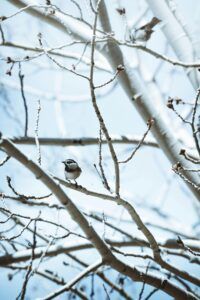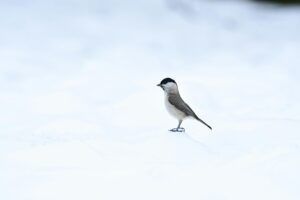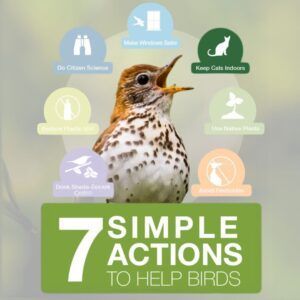Denver Audubon Blog
Dim the Lights for Birds at Night
At the time of writing this, it is predicted that tonight, March 7th, 14 million birds will fly over the United States. A profound number, yet a small percentage of the 3.5-4 billion winged beings that take to the wind each Spring and Fall, weaving together the airwaves and the planet.
This is bird migration.
Each Spring and Fall, migratory birds, which make up 70% of terrestrial birds, travel between their wintering and non-wintering grounds. 80% of these billions of travelers take to the sky at night, navigating by the stars, the earth’s rhythms and magnetism, and casting silhouettes across the moon. They fly most frequently between 11PM and 3AM, when their gentle feet alight on the next stop towards their destination.
Dr. Kyle Horton, Assistant Professor at Colorado State University in the Department of Fish, Wildlife, and Conservation Biology, shared with us that amid all the scientific facts he shares, the aforementioned one is what most consistently and profoundly impacts listeners- the wondrous phenomenon that is millions of birds flying between us and the stars as we sleep.
Together, we wondered what it is about these night migrations that inspires so many. We considered it might be the beautiful quality of mystery, how it adds layers to the avian story. That the red-headed, yellow-bodied Western Tanager at your feeder in the morning was up all night, traversing the infinite sky in his 1 oz feathered vessel. But, we know, too, that we cannot claim to know what it is that sparks the deepened appreciation in your heart.
We can claim to know, unfortunately, that our feathered friends’ night journeys are under threat, with 2.5 billion migratory birds lost since 1970. A main cause of this devastation is the rampant existence of artificial lighting! From a charming lane with a single streetlight, to dense metropolitan areas, their luminance decreases the health of migratory bird populations. The light pollution over inhabited areas, otherwise known as skyglow, can both attract and disorient birds, which leads to an inability to reach their destination. The exhaustion from the extra expended energy can also make them more susceptible to threats such as predators and window collisions- one of the leading causes of bird death.
So, what can we do?
Here in Colorado, we are part of the Central Flyway, one of four main migratory routes for birds in North America. In fact, on September 30th of 2024, approximately 25 million birds traveled across the state of Colorado between 11PM and 3AM. These birds, and birds around the globe, need our help and there are a variety of ways that we can give it.
1. Turn off non-essential lights from 11PM-6AM during migration season.
2. If indoor lights are needed at this time, install curtains that prevent light from emanating outside.
3. Install shields on outdoor lighting that prevent light from emitting upwards into the sky.
4. Install motion sensors wherever possible on outdoor lights so they illuminate only when necessary.
5. Advocate for businesses to turn out lights and for environmental laws to consider the health of migratory bird populations.
6. When converting to new lighting, assess the quality and quantity of light needed and avoid over-lighting with newer, brighter technology.
To get reminders to turn your lights out during peak migration, you can sign up for alerts here: https://aeroecolab.com/uslights.
Lastly, want to know how we knew about how many birds will be traveling tonight? Through an app called Birdcast created by CornellLab, UMassHerst, and our very own CSU, you can watch real time migrations! Click the link below for real time bird migrations.
https://birdcast.info/migration-tools/live-migration-maps/
SHARE ARTICLE
RECENT ARTICLES





